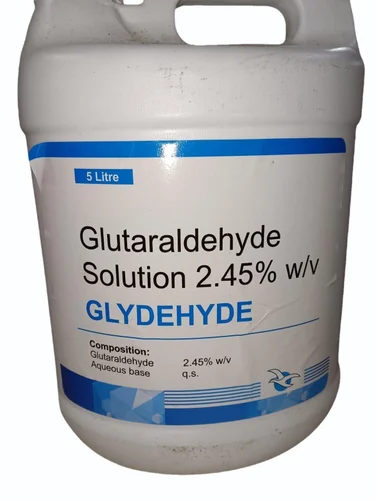🧴 Glutaraldehyde (As Licensed)
📌 1. Prescription / Indication:
Glutaraldehyde is a high-level disinfectant and sterilizing agent used primarily for medical equipment that cannot be heat-sterilized.
Common uses include:
- Cold sterilization of surgical and dental instruments (e.g., endoscopes, bronchoscopes)
- Disinfection of respiratory therapy equipment, dialyzers, anesthesia equipment
- Surface sterilization in hospitals and labs
📄 2. Description:
- A colorless oily liquid with a pungent odor, usually supplied in aqueous solution at 2% or higher.
- Commercial solutions are often activated (alkalized) before use (pH ~8.0).
- Registered under brand names like Cidex®, Steranios®, Sonacide®, Metricide®, etc.
- Usually used in concentrations of 2% to 3.2% for disinfection.
🔬 3. Nature / Class:
- Chemical class: Dialdehyde
- Disinfectant type: High-level disinfectant / chemical sterilant
- Mechanism: Alkylates microbial cell components, including proteins, RNA, and DNA, leading to inactivation
🌟 4. Advantages:
- Broad-spectrum: Kills bacteria (incl. TB), viruses, fungi, and spores
- Non-corrosive to metal and plastics
- Can be used for heat-sensitive instruments
- Stable when activated (usable for up to 14 days)
- Effective in organic matter (unlike many disinfectants)
📦 5. Common Packaging:
- Supplied in 1 L, 2.5 L, 5 L plastic bottles or jugs
- Often comes in two-part packs (one part for activation)
- Includes a dipstick or indicator strip for potency monitoring
- Labeled as:
- “Glutaraldehyde 2% solution (activated)”
- “Glutaraldehyde sterilizing/disinfecting solution”
🧊 6. Storage:
- Store at room temperature (15–25°C)
- Keep in a well-ventilated area
- Avoid direct sunlight and heat
- Activated solutions should be discarded after 14 days (or per manufacturer instructions)
👩⚕️ 7. Patient / User Advice:
- Not for direct application to human skin or tissues
- Use gloves, goggles, and face masks while handling
- Only use in well-ventilated environments or under fume hoods
- Rinse medical instruments thoroughly with sterile water after exposure
- Do not mix with other disinfectants (may release toxic gases)
- Ensure instruments are completely submerged during exposure
⚠️ 8. Precautions / Hazards:
- Irritant to eyes, skin, and mucosa
- Toxic when inhaled; prolonged exposure linked to occupational asthma and respiratory distress
- Use air extraction or closed systems to reduce vapor exposure
- Do not reuse solution beyond its efficacy period
- Dispose of according to hazardous waste guidelines

